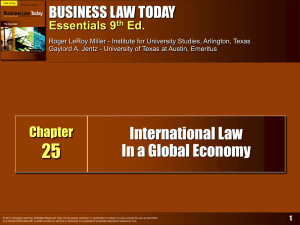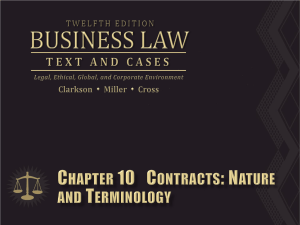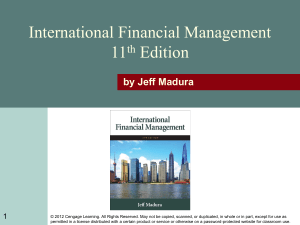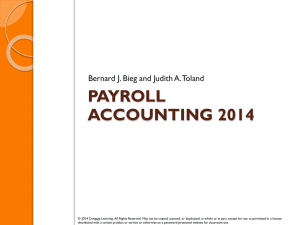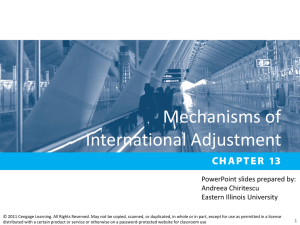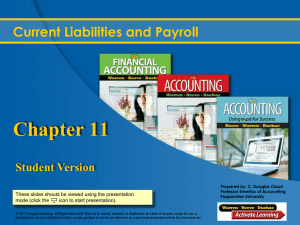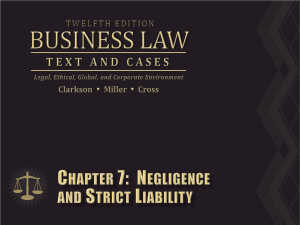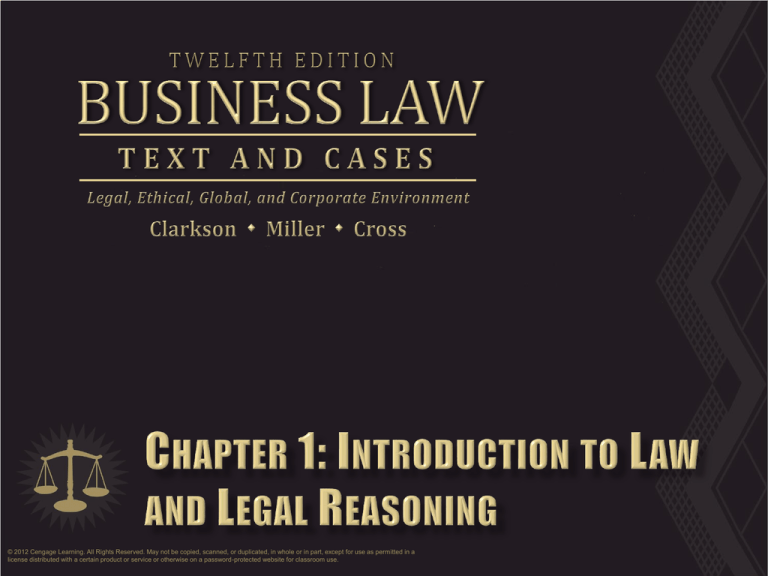
© 2012 Cengage Learning. All Rights Reserved. May not be copied, scanned, or duplicated, in whole or in part, except for use as permitted in a
license distributed with a certain product or service or otherwise on a password-protected website for classroom use.
Laws and regulations affect virtually
all business activities.
Knowledge of ‘black-letter’ not
enough - business now assumes an
ethical dimension.
Many different laws may affect a
single business transaction.
© 2012 Cengage Learning. All Rights Reserved. May not be copied, scanned, or duplicated, in whole or in part, except for use as permitted in a
license distributed with a certain product or service or otherwise on a password-protected website for classroom use.
2
© 2012 Cengage Learning. All Rights Reserved. May not be copied, scanned, or duplicated, in whole or in part, except for use as permitted in a
license distributed with a certain product or service or otherwise on a password-protected website for classroom use.
3
Constitutional Law.
Statutory Law.
Ordinances.
Uniform Laws (NCCUSL).
Uniform Commercial Code.
© 2011
2012 Cengage Learning. All Rights Reserved. May not be copied, scanned, or duplicated, in whole or in part, except for use as permitted in a
license distributed with a certain product or service or otherwise on a password-protected website for classroom use.
4
Administrative Law.
Federal Agencies.
State and Local Agencies.
Case Law and Common Law
Doctrines.
© 2012 Cengage Learning. All Rights Reserved. May not be copied, scanned, or duplicated, in whole or in part, except for use as permitted in a
license distributed with a certain product or service or otherwise on a password-protected website for classroom use.
5
American law is based largely on
English Common Law which was
based largely on traditions, social
customs, rules, and cases dating
back to 1066 A.D.
© 2012 Cengage Learning. All Rights Reserved. May not be copied, scanned, or duplicated, in whole or in part, except for use as permitted in a
license distributed with a certain product or service or otherwise on a password-protected website for classroom use.
6
At common law, there were two
separate court systems with two
different types of remedies:
COURTS OF LAW
(monetary relief), and
COURTS OF EQUITY (non-monetary
relief) based on “notions of justice and
fair dealing.”
© 2012 Cengage Learning. All Rights Reserved. May not be copied, scanned, or duplicated, in whole or in part, except for use as permitted in a
license distributed with a certain product or service or otherwise on a password-protected website for classroom use.
7
Also called “king’s courts”: judges
were appointed by the king.
Remedies limited to those provided
at law, i.e., land, chattel, money.
Judges resolved disputes by
application of rules of law to the
facts of the case before the court.
© 2012 Cengage Learning. All Rights Reserved. May not be copied, scanned, or duplicated, in whole or in part, except for use as permitted in a
license distributed with a certain product or service or otherwise on a password-protected website for classroom use.
8
Equity is branch of law founded on
what is fair and just.
Courts of equity were administered
by chancellors appointed by the king.
Equitable remedies include: specific
performance, injunctions, rescissions.
© 2012 Cengage Learning. All Rights Reserved. May not be copied, scanned, or duplicated, in whole or in part, except for use as permitted in a
license distributed with a certain product or service or otherwise on a password-protected website for classroom use.
9
© 2012 Cengage Learning. All Rights Reserved. May not be copied, scanned, or duplicated, in whole or in part, except for use as permitted in a
license distributed with a certain product or service or otherwise on a password-protected website for classroom use.
10
Federal and state courts have
consolidated remedies at law and
equity.
Generally, the same court can
fashion a remedy that includes both
damages and equitable or injunctive
relief.
© 2012 Cengage Learning. All Rights Reserved. May not be copied, scanned, or duplicated, in whole or in part, except for use as permitted in a
license distributed with a certain product or service or otherwise on a password-protected website for classroom use.
11
Stare Decisis (“to stand on decided
cases”) is judge-made law.
Case Precedents and Reporters.
Each decision and interpretation
becomes a legal precedent.
Cases are now published in national and
regional “Reporters” (discussed later in
Chapter 1).
© 2012 Cengage Learning. All Rights Reserved. May not be copied, scanned, or duplicated, in whole or in part, except for use as permitted in a
license distributed with a certain product or service or otherwise on a password-protected website for classroom use.
12
Stare Decisis and the Common Law
Tradition.
Courts are obliged to follow precedents
within their jurisdictions.
Courts should not overturn their own
precedents without compelling reasons.
Stare Decisis and Legal Stability.
© 2012 Cengage Learning. All Rights Reserved. May not be copied, scanned, or duplicated, in whole or in part, except for use as permitted in a
license distributed with a certain product or service or otherwise on a password-protected website for classroom use.
13
Departures from Precedent.
In cases of “first impression” where
there is no precedent, the court may
refer to positive law, public policy, and
widely held social values in order to craft
the best new precedent.
When There is No Precedent.
© 2012 Cengage Learning. All Rights Reserved. May not be copied, scanned, or duplicated, in whole or in part, except for use as permitted in a
license distributed with a certain product or service or otherwise on a password-protected website for classroom use.
14
Basic Steps (IRAC format):
Key Facts and Issues (What are the
questions to be answered?)
Rules (What laws governs this matter?)
Application (How do the rules of law
apply to these facts?)
Conclusion (Decision or Verdict)
© 2012 Cengage Learning. All Rights Reserved. May not be copied, scanned, or duplicated, in whole or in part, except for use as permitted in a
license distributed with a certain product or service or otherwise on a password-protected website for classroom use.
15
Deductive Reasoning: Makes use of
syllogism, a type of logical
relationship involving a major
premise and a minor premise.
Linear Reasoning: Proceeds from
point to point, with the final point
being the conclusion.
© 2012 Cengage Learning. All Rights Reserved. May not be copied, scanned, or duplicated, in whole or in part, except for use as permitted in a
license distributed with a certain product or service or otherwise on a password-protected website for classroom use.
16
Reasoning by Analogy: Analysis
that compares facts of present case
with facts of similar previouslydecided cases.
© 2012 Cengage Learning. All Rights Reserved. May not be copied, scanned, or duplicated, in whole or in part, except for use as permitted in a
license distributed with a certain product or service or otherwise on a password-protected website for classroom use.
17
Good arguments are made for
different sides.
Judges have personal beliefs that
can affect decisions.
Outcomes to lawsuits cannot be
predicted with certainty.
© 2012 Cengage Learning. All Rights Reserved. May not be copied, scanned, or duplicated, in whole or in part, except for use as permitted in a
license distributed with a certain product or service or otherwise on a password-protected website for classroom use.
18
Common law governs transactions
not covered by statutory law.
Courts interpret statutes.
Restatements of the Law.
Summarize the common law of most
states.
American Law Institute.
© 2012 Cengage Learning. All Rights Reserved. May not be copied, scanned, or duplicated, in whole or in part, except for use as permitted in a
license distributed with a certain product or service or otherwise on a password-protected website for classroom use.
19
Natural Law School.
Positivist School.
Historical School.
Legal Realism.
© 2012 Cengage Learning. All Rights Reserved. May not be copied, scanned, or duplicated, in whole or in part, except for use as permitted in a
license distributed with a certain product or service or otherwise on a password-protected website for classroom use.
20
Assumes law, rights and ethics are based
on universal moral principals inherent in
nature discoverable through human
reason.
The oldest view of jurisprudence dating
back to Aristotle.
The Declaration assumes natural law, or what
Jefferson called “the Laws of Nature.”
© 2012 Cengage Learning. All Rights Reserved. May not be copied, scanned, or duplicated, in whole or in part, except for use as permitted in a
license distributed with a certain product or service or otherwise on a password-protected website for classroom use.
21
Letter from the Birmingham Jail, April 16,
1963. “[T]here are two types of laws: just
and unjust laws. . . . A just law is a manmade code that squares with the moral law .
. . . An unjust law is a code that is out of
harmony with the moral law. . . . An unjust
law is a human law that is not rooted in
eternal and natural law.”
© 2012 Cengage Learning. All Rights Reserved. May not be copied, scanned, or duplicated, in whole or in part, except for use as permitted in a
license distributed with a certain product or service or otherwise on a password-protected website for classroom use.
22
Law is the supreme will of the State
that applies only to the citizens of
that nation at that time.
Law, and therefore rights and ethics,
are not universal. The morality of a
law, or whether the law is “bad or
good,” is irrelevant.
© 2012 Cengage Learning. All Rights Reserved. May not be copied, scanned, or duplicated, in whole or in part, except for use as permitted in a
license distributed with a certain product or service or otherwise on a password-protected website for classroom use.
23
Emphasizes the evolutionary
process of law.
Concentrates on the origins of the
legal system.
Law derives its legitimacy and
authority from standards that have
withstood the test of time.
© 2012 Cengage Learning. All Rights Reserved. May not be copied, scanned, or duplicated, in whole or in part, except for use as permitted in a
license distributed with a certain product or service or otherwise on a password-protected website for classroom use.
24
Jurisprudence that holds law is not
simply a result of the written law,
but a product of the views of
judicial decision makers, as well as
social, economic, and contextual
influences.
© 2012 Cengage Learning. All Rights Reserved. May not be copied, scanned, or duplicated, in whole or in part, except for use as permitted in a
license distributed with a certain product or service or otherwise on a password-protected website for classroom use.
25
Every type of law will be either:
Civil or Criminal.
Substantive or Procedural.
Public or Private.
© 2012 Cengage Learning. All Rights Reserved. May not be copied, scanned, or duplicated, in whole or in part, except for use as permitted in a
license distributed with a certain product or service or otherwise on a password-protected website for classroom use.
26
Civil law defines the rights
between individuals or individuals
and governments.
Criminal law defines an individual’s
obligations to society as a whole.
© 2012 Cengage Learning. All Rights Reserved. May not be copied, scanned, or duplicated, in whole or in part, except for use as permitted in a
license distributed with a certain product or service or otherwise on a password-protected website for classroom use.
27
Substantive law defines or creates
the rights and obligations of persons
and governments.
Procedural law provides the steps
one must follow in order to avail
oneself of one’s legal rights or
enforce another’s legal obligations.
© 2012 Cengage Learning. All Rights Reserved. May not be copied, scanned, or duplicated, in whole or in part, except for use as permitted in a
license distributed with a certain product or service or otherwise on a password-protected website for classroom use.
28
Not really a new type of law.
Traditional legal rules applied to
online transactions.
Applies to advertising, contracting,
banking, filing documents with
courts, employment relations and
other transactions.
© 2012 Cengage Learning. All Rights Reserved. May not be copied, scanned, or duplicated, in whole or in part, except for use as permitted in a
license distributed with a certain product or service or otherwise on a password-protected website for classroom use.
29
Citation: identifies a legal publication in
which legal authority is found.
Finding Statutory Law and
Administrative Law.
United States Code (USC).
www.gpoacess.gov/uscode
State Codes.
Administrative Rules.
© 2012 Cengage Learning. All Rights Reserved. May not be copied, scanned, or duplicated, in whole or in part, except for use as permitted in a
license distributed with a certain product or service or otherwise on a password-protected website for classroom use.
30
Finding Case Law.
State Court Decisions.
Regional Reporters.
Case Citations.
Federal Court Decisions.
United States Supreme Court decisions are published
by the federal government in United States Reports
(U.S.). The U.S. Supreme Court website is
www.supremecourt.gov
© 2012 Cengage Learning. All Rights Reserved. May not be copied, scanned, or duplicated, in whole or in part, except for use as permitted in a
license distributed with a certain product or service or otherwise on a password-protected website for classroom use.
31
Legal cases are identified by a “legal
citation” (or a “cite”) as the sample
below:
Singer v. Raemisch, 593 F.3d 529 (7th
Circuit, 2010).
Title: First Party is Plaintiff, second
party is Defendant. The parties are
either italicized or underlined.
© 2012 Cengage Learning. All Rights Reserved. May not be copied, scanned, or duplicated, in whole or in part, except for use as permitted in a
license distributed with a certain product or service or otherwise on a password-protected website for classroom use.
32
Legal cases are identified by a “legal
citation” (or a “cite”) as the sample
below:
Singer v. Raemisch, 593 F.3d 529 (7th
Circuit, 2010).
The case is found in the Federal
Reporters, the 3rd Edition, Volume 593,
page 529.
© 2012 Cengage Learning. All Rights Reserved. May not be copied, scanned, or duplicated, in whole or in part, except for use as permitted in a
license distributed with a certain product or service or otherwise on a password-protected website for classroom use.
33
Legal cases are identified by a “legal
citation” (or a “cite”) as the sample
below:
Singer v. Raemisch, 593 F.3d 529 (7th
Circuit, 2010).
The case was decided by the United
States Court of Appeals, for the
Seventh Circuit, in 2010.
© 2012 Cengage Learning. All Rights Reserved. May not be copied, scanned, or duplicated, in whole or in part, except for use as permitted in a
license distributed with a certain product or service or otherwise on a password-protected website for classroom use.
34


